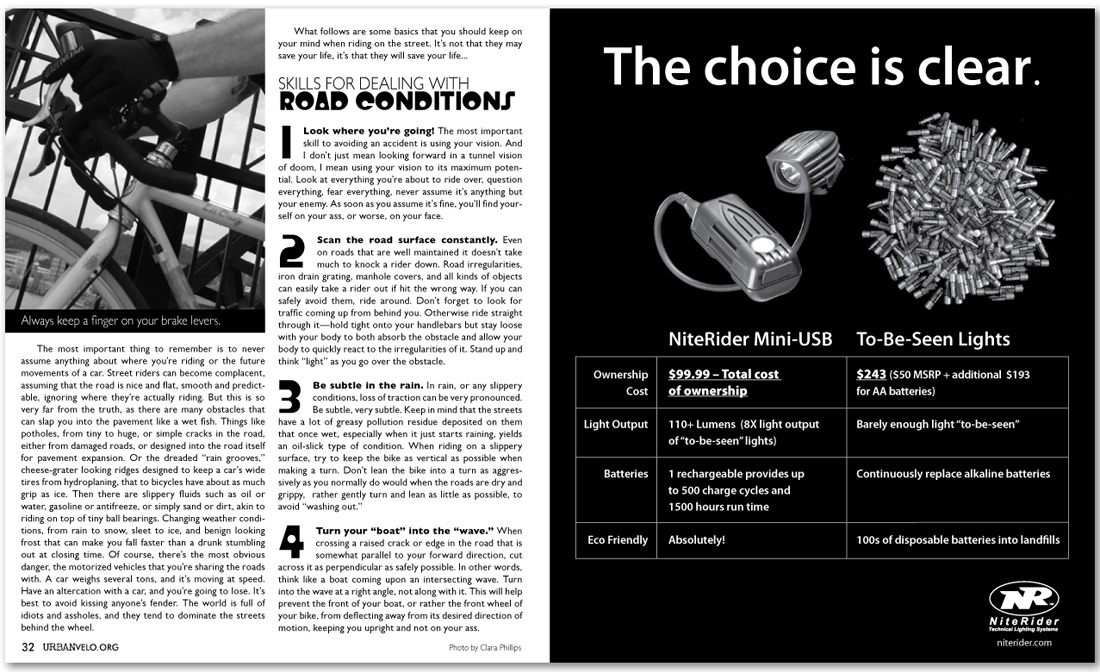The most important thing to remember is to never assume anything about where you’re riding or the future movements of a car. Street riders can become complacent, assuming that the road is nice and flat, smooth and predictable, ignoring where they’re actually riding. But this is so very far from the truth, as there are many obstacles that can slap you into the pavement like a wet fish. Things like potholes, from tiny to huge, or simple cracks in the road, either from damaged roads, or designed into the road itself for pavement expansion. Or the dreaded “rain grooves,” cheese-grater looking ridges designed to keep a car’s wide tires from hydroplaning, that to bicycles have about as much grip as ice. Then there are slippery fluids such as oil or water, gasoline or antifreeze, or simply sand or dirt, akin to riding on top of tiny ball bearings. Changing weather conditions, from rain to snow, sleet to ice, and benign looking frost that can make you fall faster than a drunk stumbling out at closing time. Of course, there’s the most obvious danger, the motorized vehicles that you’re sharing the roads with. A car weighs several tons, and it’s moving at speed. Have an altercation with a car, and you’re going to lose. It’s best to avoid kissing anyone’s fender. The world is full of idiots and assholes, and they tend to dominate the streets behind the wheel.
What follows are some basics that you should keep on your mind when riding on the street. It’s not that they may save your life, it’s that they will save your life...
SKILLS FOR DEALING WITH ROAD CONDITIONS
1 Look where you’re going! The most important skill to avoiding an accident is using your vision. And I don’t just mean looking forward in a tunnel vision of doom, I mean using your vision to its maximum potential. Look at everything you’re about to ride over, question everything, fear everything, never assume it’s anything but your enemy. As soon as you assume it’s fine, you’ll find yourself on your ass, or worse, on your face.
2 Scan the road surface constantly. Even on roads that are well maintained it doesn’t take much to knock a rider down. Road irregularities, iron drain grating, manhole covers, and all kinds of objects can easily take a rider out if hit the wrong way. If you can safely avoid them, ride around. Don’t forget to look for traffic coming up from behind you. Otherwise ride straight through it—hold tight onto your handlebars but stay loose with your body to both absorb the obstacle and allow your body to quickly react to the irregularities of it. Stand up and think “light” as you go over the obstacle.
3 Be subtle in the rain. In rain, or any slippery conditions, loss of traction can be very pronounced. Be subtle, very subtle. Keep in mind that the streets have a lot of greasy pollution residue deposited on them that once wet, especially when it just starts raining, yields an oil-slick type of condition. When riding on a slippery surface, try to keep the bike as vertical as possible when making a turn. Don’t lean the bike into a turn as aggressively as you normally do would when the roads are dry and grippy, rather gently turn and lean as little as possible, to avoid “washing out.”
4 Turn your “boat” into the “wave.” When crossing a raised crack or edge in the road that is somewhat parallel to your forward direction, cut across it as perpendicular as safely possible. In other words, think like a boat coming upon an intersecting wave. Turn into the wave at a right angle, not along with it. This will help prevent the front of your boat, or rather the front wheel of your bike, from deflecting away from its desired direction of motion, keeping you upright and not on your ass.
